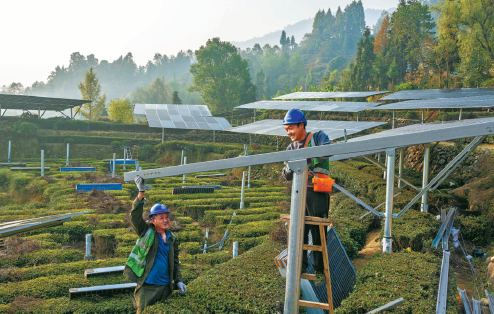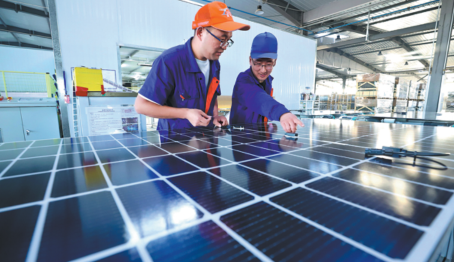Global cooperation key to climate success

International Renewable Energy Agency chief: More efforts needed to address environmental issues, reach carbon goals
Accelerated global action is urgently needed to reach climate goals and cooperation is essential to advance collective efforts, as the world is currently off track in achieving the goal of tripling the installed capacity of renewable energy by 2030, set at the 2023 COP28 climate conference, said Francesco La Camera, director-general of the International Renewable Energy Agency.
Tripling renewables is essential to cut emissions and keep the Paris Agreement goal of limiting global warming to 1.5 C within reach, La Camera said in a recent interview with China Daily.
Against this backdrop, the global capacity of renewable energy needs to surpass 11,174 gigawatts by 2030, with an average annual increase of 1,044 GW from 2024 to 2030, IRENA's analysis showed.
This includes 360 GW of wind power and 578 GW of solar power each year, it said.
Last year, the global addition of renewable power capacity was 473 GW.
"This puts us not on track. We really have to change rapidly the speed and the scale of this transformation, if you want to stay, again, on a pathway that's going to achieve (the Paris Agreement target)," he said.
La Camera reaffirmed that global cooperation is paramount in achieving shared climate goals. He said initiatives to promote information exchange, facilitate market functionality, and reduce tariffs on renewable energy-related goods are essential for fostering collaboration among nations.
Yet, global cooperation in the energy transition sector is facing great challenges, with trade tariffs being an issue.
"It's really difficult to accept this deal that the trade tariffs are more favorable for fossil fuels and related goods, and really not like that for renewable goods. These are really not acceptable. These kinds of things have to change if a country wants to collaborate more closely on going toward the common goal, because climate change is not the fight of one country, but is the fight of the world against this menace for the world itself," La Camera said.
Meanwhile, trade conflicts between countries are also accelerating. In May, the US government decided to impose additional tariffs on imports of Chinese products like electric vehicles, lithium-ion batteries and solar cells on top of existing tariffs. Specifically, the import tax on Chinese solar cells will rise from 25 percent to 50 percent.
Wang Bohua, honorary chairman of the China Photovoltaic Industry Association, said at a forum that in the first half, major global photovoltaic markets such as the United States, Europe, India and Brazil rolled out policies that increased barriers to PV product imports and launched measures to protect local production, posing challenges to global cooperation.
In October, the European Commission, the EU's executive arm, announced the conclusion of its anti-subsidy investigation, resulting in the imposition of definitive countervailing duties on Chinese-made electric vehicles. Later, the Ministry of Commerce said China had appealed to the World Trade Organization against EU's final ruling.
"China is providing the world the panel, the blade, storage facilities at a reasonable price … the country is pushing the global energy transition," said La Camera.
Over the past decade, average power costs per kilowatt-hour of wind and solar power projects in China have fallen by over 60 percent and 80 percent, respectively, Zhang Jianhua, head of the National Energy Administration, said at a recent conference.
Such a cost reduction is meaningful in providing affordable solar panels and wind turbines to regions in need.
A report from the International Energy Agency showed that electricity consumption in emerging and developing economies is set to grow around three times the rate of advanced economies, and the low costs of wind and solar power, in particular, should make them the technologies of choice to meet rising demand if the infrastructure and regulatory frameworks are in place.
China has to date contributed over 80 percent of photovoltaic modules and 70 percent of wind power equipment. Its products have been exported to over 200 countries and regions, Zhang of NEA said.
La Camera said China plays an indispensable role in ensuring the realization of global climate goals as it is spearheading the global transition toward sustainable practices.
"IRENA places great importance on its cooperation with China and hopes that by further leveraging the role of China-IRENA cooperation office as a bridge and hub, both sides can reap more practical outcomes in areas such as policy dialogue, technical discussions and capacity building."
"China is currently at the forefront of renewable energy deployment worldwide … It is noteworthy that approximately 40 percent of global solar capacity is located in China. Moreover, a significant portion of renewable energy jobs can be found within the country," La Camera said.
As of end-September, installed capacity of renewable energy power generating units in China reached 1.73 billion kW, a year-on-year increase of 25 percent, accounting for approximately 54.7 percent of the total installed capacity in China, latest data from the NEA showed.
This includes hydropower installations of 430 million kW, wind power installations of 480 million kW, solar power installations of 770 million kW, and biomass power installations of 46 million kW.
Meanwhile, renewable energy consumption has been steadily increasing. In the first three quarters, power generated from renewable energy sources reached 2.51 trillion kilowatt-hours, a 20.9 percent year-on-year increase, representing about 35.5 percent of total electricity.
Combined electricity generated from wind and solar power reached 1.349 trillion kWh, a 26.3 percent increase year-on-year, nearly matching the electricity consumption of the tertiary sector (1.395 trillion kWh) during the same period and surpassing electricity consumption for urban and rural residents (1.172 trillion kWh).
China is also stepping up efforts to promote the development of electric vehicles and charging infrastructure, and actively participating in global trade despite ongoing conflicts, La Camera said.
"We see that there is an incredible progress in transport — the electric vehicles, if you go into the street, you see so many green plates, which means that there are many electric vehicles … China's technology advancement also allows for battery recharging in a very short time."
"We have seen that there is interest in hydropower, in power storage, and in hydrogen (in China). So these are all areas where the country is progressing fast. Furthermore, the country's commitment to achieving 1.2 terawatts of renewable capacity six years ahead of schedule exemplifies its dedication to environmental stewardship, providing reference to other countries that need to accelerate its renewable deployment," he said.
"China may achieve carbon neutrality well in advance of the target year of 2060," he added.
The rapid expansion of renewable energy sources has driven the need for energy storage facilities, as such intermittent energy sources cannot be managed and dispatched like traditional fossil fuels. According to the NEA, innovative energy storage systems, distinct from traditional methods like pumped storage hydropower, have served as vital "super power banks" for renewable energy, significantly bolstering power supply during peak demand.
By the end of September, China had 58.52 million kW of operational innovative energy storage facilities, marking an 86 percent increase from the end of 2023. Particularly in East China, there has been notable growth in these installations, with over 9 million kW added this year. Between January and August, the total charge and discharge capacity of innovative energy storage systems nationwide reached around 26 billion kWh.
"The country may still face challenges, as in all other countries. When putting so much renewable energy capacity into the system, we need a grid system that is interconnected, flexible, moving from one direction to another, and balancing," La Camera said.
An upgrade of the grid system is necessary to efficiently transmit and balance electron flow generated from intermittent renewable sources, he added.
To tackle these challenges, China is accelerating investments in ultrahigh-voltage direct current transmission projects, with related grid construction making solid progress. At the same time, China has introduced a new type of power system, with the primary goal of maximizing the integration of new energy sources, utilizing smart grid, and encouraging electricity generator-grid-power load-power storage integration.
"Building a diversified, clean and stable energy supply system is an important path for developing countries to enhance their energy security capabilities," Zhang of the NEA said. "We are willing to work with other countries around the world to develop more ambitious green energy development plans based on each country's endowments and development needs."
liuyukun@chinadaily.com.cn
























